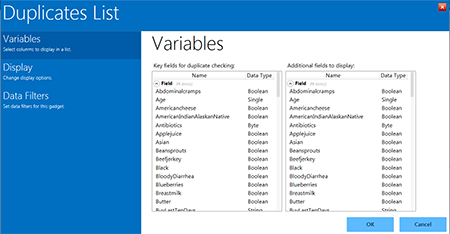Visual Dashboard: Performing Statistical Analyses with Visual Tools
Visual Dashboard
Analysis Gadgets
Duplicates List
The Duplicates List gadget in Visual Dashboard is used to list potentially duplicate records. In some situations, as with a patient registry for example, it is important each individual has only one record. The Duplicates List gadget allows you to select a few fields that should be unique, and a few other non-unique fields to display. When the gadget runs, it counts the number of occurrences of the key fields for duplicate checking. The gadget displays the message, “No records match the selection criteria” if all rows in the database are unique for the key fields. If any database rows have key fields that match another row, those matching rows are listed in the results.
In the example below, assume a patient registry with a small population, where two individuals sharing the same last name and birthdate is very unlikely. The goal is to check the database to see if there are duplicate records based on the Date of Birth field [DOB] and the Last Name field [LastName]. If we find a match, we might also want to see the few other fields, such as CaseID, DateofInterview, and OnsetDate in order to conclude that individual is actually duplicated in the registry.
- Open the EColi.PRJ project and select the Food History form.
- Right click on the canvas and select Add Analysis Gadget > Duplicates List. The Duplicates List gadget configuration window opens to the Variables property panel.
Figure 8.41: Duplicates list gadget
- In the Key fields for duplicate checking list, select DOB and LastName by holding down the CTRL key and clicking on the respective field names.
- In the Additional fields to display list, select the other fields to help determine if the record is a true duplicate such as CaseID, DateofInterview, DoctorVisit, DoctorVisitDate, and OnsetDate. Hold down the CTRL key and click of the field names.
- Click OK.
- The system returns any duplicate records in the database. In this example, patients Johnson and Garcia have duplicate records in the database. They were each interviewed on different days and assigned different case IDs.

Figure 8.42: Duplicates list results
